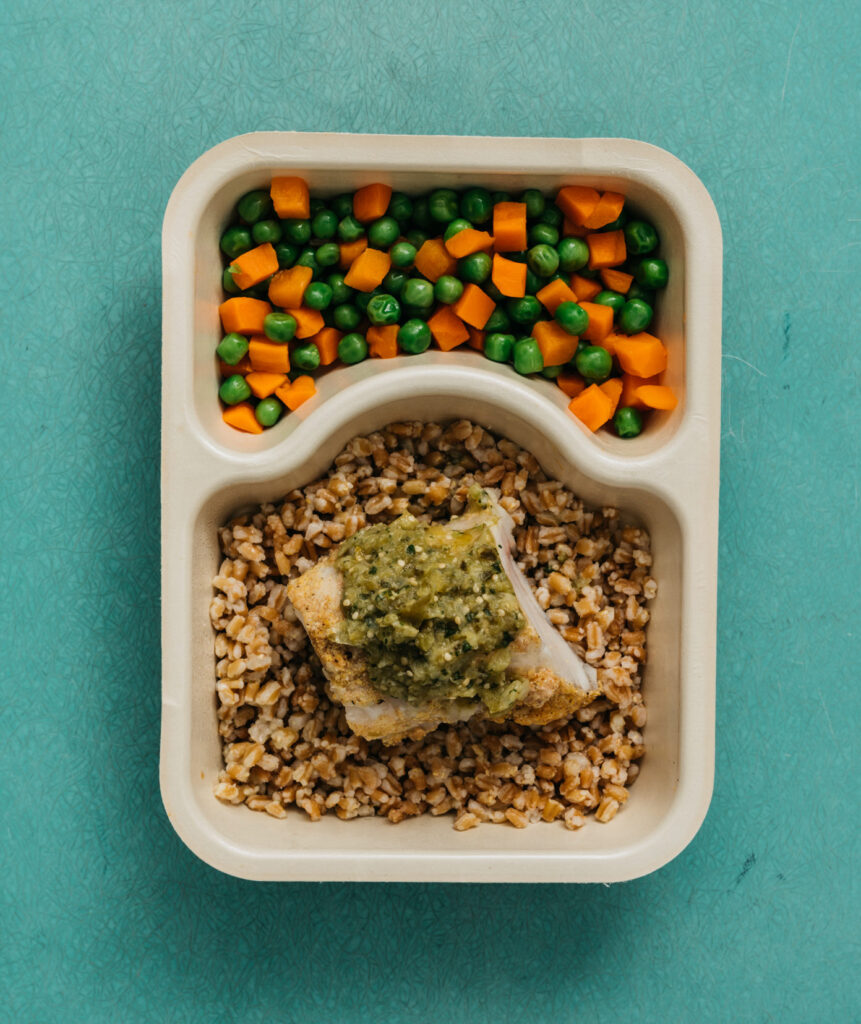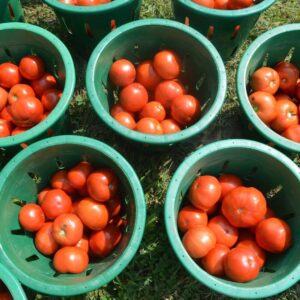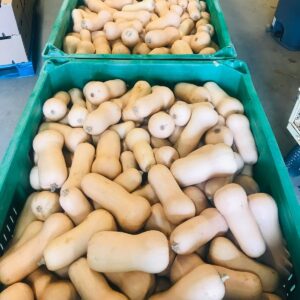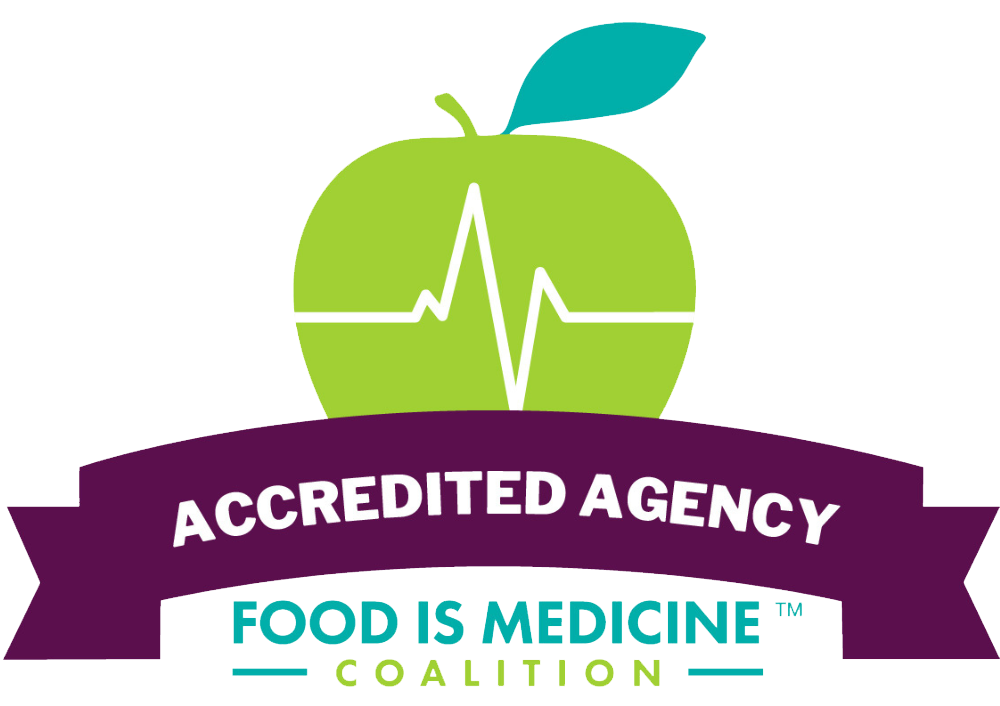Every week the average American spends 41 minutes driving to and from the grocery store and 46 minutes shopping for groceries. But one of the most significant parts of grocery shopping is much harder to measure: deciding where to do it.
“Most consumers choose the path of least resistance and lowest upfront cost,” says Chief Culinary Officer Brian Hillmer. “That’s usually the conventional supply chains.”
The basic bind of grocery shopping applies to Community Servings, as well. In our day-to-day operations, we regularly toggle between the conventional market, our “path of least resistance,” and the alternate route, which entails an array of local growers and suppliers who provide us foods that we fold into production at scale.
Our Local Foods Program is a critical (albeit behind-the-scenes) part of our mission to deliver medically tailored meals to people living with critical or chronic illnesses and nutrition insecurity. It’s also something to brag about, because it’s the most impactful way we invest in a sustainable, community-driven food economy in New England.
Why Local Foods Matter

Dave Johnson, Manager of Farm Operations at Community Harvest Project
Massachusetts residents have a robust tradition of getting their food from farmers markets and farm stands. However, some consumers access their local farmers more easily than others. “The farm-stand demographic is usually folks who have the means to be selective,” says Dave Johnson, Manager of Farm Operations at Community Harvest Project, a partner of ours—and an organization expanding local-food access to people who are experiencing food insecurity.
A nonprofit farm in Grafton, Massachusetts, Community Harvest Project convenes volunteer farmers to plant and harvest fruits and vegetables for the exclusive purpose of donating to hunger relief agencies. These agencies, which include Lovin Spoonfuls, Family Health Center of Worcester County, Worcester County Food Bank, and Latin American Health Alliance, provide donations to innovative group-based care programs, such as pregnancy and addiction recovery programs.
“It’s all planted with the intention of going toward hunger relief,” Dave says of his organization’s crops. “Access to produce in general is fairly exclusive. So, it’s a really cool thing, in the work that I do, to be able to blow open that accessibility and send people locally grown produce from the farm up the road.”
It’s because of like-minded organizations such as Community Harvest Project that Community Servings can serve clients the best ingredients New England has to offer.
“Because of partners like CHP, we can provide clients the highest-quality produce available,” Chef Brian says. “Because of how the commercial supply chain works, how expensive and boutique organic produce can be, this kind of high-quality food is more difficult to access for many people. It’s a huge deal to me that we make product this good available to our clients. They’re the ones who can benefit the most from a health perspective. That’s huge.”
We have other partners, too, such as Boston Area Gleaners, Misty Knoll Farms, Robie Farms, and Siena Farms. They produce high-quality foods in our region using ethical, sustainable practices. Because of them, we participate in shorter supply chains, reducing our reliance on costly modes of transportation and shipping. Our clients have access to minimally processed, nutritious, and delicious ingredients. And, on a larger scale, the value of New England’s food economy sustains the people—the consumers, laborers, and buyers—who live and work in New England.
Our vision is a world where everyone has access to the nutritious food necessary for health and well-being. That’s why, every day, we are making purposeful decisions, large and small, out-front and behind-the-scenes, to invest in systems that move us in a sustainable direction.
Embracing Value and Wasting Less
Located just down the road from us in Jamaica Plain is the manufacturing plant of 21st Century Foods, our tofu supplier. Every month, 21st Century sends us over 1,000 pounds of artisanal, non-GMO tofu processed from beans grown in the state of New York.
“Tofu is never fresher than when it’s made and delivered by your neighbor,” Chef Brian says. “21st Century makes the best tofu I’ve ever had.”
While some meat-eaters shy away from this plant-based food, tofu plays an indispensable role in our kitchen because of its culinary adaptability and nutritional value.
“Tofu is a complete protein, containing all 9 essential amino acids that the body can’t produce on its own. And it’s low in saturated fat,” says Shennie Quintanilla, RDN. “But the really great thing about tofu is how many creative spins it can take.”
In our entrees, tofu is saucy, succulent, and low in sodium and sugar. “We take advantage of its versatility in popular recipes to replicate textures and flavors that would otherwise require ingredients that aren’t always aligned with our clients’ nutritional priorities,” Chef Brian explains. We make General Tso’s Tofu and Sweet and Spicy Tofu, for instance, with irresistible ingredients like ginger, garlic, shichimi, white wine vinegar, and hoisin sauce.
In past years, Rudy Canale, the founder of 21st Century Foods, transported the tofu to Community Servings himself by bicycle. In retirement, Rudy remains a regular visitor. But these days he’s picking up returned delivery bags and transporting them to Boston Community Fridge, a local food-insecurity initiative. Rudy’s dream is that, in his words, “Nothing goes to waste.”
A similar ethic describes Community Servings’ seafood supplier.
Every month, we purchase 2,600 pounds of fresh fish from Red’s Best, which provides a steady living wage to a network of New England fishers harvesting the Western Atlantic using responsible and sustainable fishing practices. Community Servings’ fish are often under-utilized species or bycatch.
Sometimes misunderstood, the term bycatch refers to the unintended capture of nontarget species. In other harvesting models, bycatch would be tossed out because of its lower market value. Buyers like us incentivize fishers to land more of their catch and help guarantee a fair minimum price for their fish. The fishers’ job, as a result, is less onerous. Fishers require less time at sea, they discard fewer fish, and their work exacts a lesser environmental impact.

“This is the freshest fish in New England and it’s going straight to our clients.”
In entrees like Cilantro Hake, Fish Pot Pie, and Herb-Marinated Monkfish, we use healthy, flavorful seasonings that showcase the natural qualities of the ingredients. “This is the freshest fish in New England and it’s going straight to our clients,” Chef Brian says. “This is, professionally, a huge point of pride for me.”
“The fish we deliver our clients provides them a great source of complete protein, essential fatty acids, and iron,” says Lindsay Verraster, MPH, RDN, LDN. “We’re not frying fish. We’re preparing it in ways that taste good without sacrificing nutritional value.”
Making the Most of Everything
Before working with Community Servings, Community Harvest Project had no outlet for its “seconds,” harvested fruits and vegetables that have modest cosmetic imperfections—a gigantic zucchini, for instance, or a carrot with two legs. Seconds are a fact of life for farmers. “Every farm produces a massive amount of B-grade harvest,” Dave explains. Thanks to Community Servings, however, 500 to 1,500 pounds of safe, edible produce dodge the compost heap weekly during the growing season.
“Community Servings is unique among our partners,” Dave says. “There are certain crops we grow with you guys in mind.” Okra is one, used in sides and as a natural general-purpose thickener. So are basil and parsley, which tend to be too lightweight and shelf-unstable to justify big investment for farmers. Community Harvest Project grows them because, through conversation with Chef Brian and his team, Dave knows we need them—and he knows how and why.
“It’s been very inspiring to talk to Brian about the different MTM tiers and how flavor is king in the food you prepare,” Dave shares. “Brian doesn’t have the luxury of being able to put a ton of sodium to make something taste good. The ingredients have to make it taste good.”

Every year, Community Harvest Project supplies us with 13,000 pounds of tomatoes.
Big picture, Community Harvest Project supplies us with 36,000 pounds of vegetables a year: a slew of peppers, eggplant, zucchini, summer and winter squash, cucumbers, kale, collards, Swiss chard, carrots, sweet potatoes, radishes, kohlrabi, and broccoli. That’s not counting 13,000 pounds of tomatoes every year, too.
“It was so inspiring when I started to talk to Brian and understand how the choices are made,” Dave says of vegetables’ use in production. Cucumbers become cupcakes. Zucchini goes into pasta sauce, where it provides body and extra nutrition. We transform eggplant into caponata, cauliflower into shepherd’s pie topping, and, provided the weather cooperates, heirloom tomatoes into gazpacho.
Locally grown produce likely has significant health benefits, as well. Produce picked at peak ripeness and sold right away is richer in nutrients, such as vitamins A and C, potassium, magnesium, and phosphorous. When the supply chain is short, there is a lower risk produce will carry bacteria and viruses.
Local farmers like Community Harvest Project exercise environmental responsibility, as well. They use organic pesticides that degrade safely and apply them in a manner that minimizes the risk of passing along contaminants to consumers. “All of our practices for growing our vegetables are organic,” Dave explains. “We do spray. But we use application methods that are responsible. We fight bio with bio. It’s ecologically sound. For certain pests, we use a live bacteria, derived from a soil bacteria or flowers, like chrysanthemums and marigolds. They are still chemicals, but they are organic chemicals and break down organically in the environment.”
Growing Better
So why doesn’t Community Servings use local foods exclusively?
It’s a fair question. The answer comes down to the state of the agriculture industry generally and limitations particular to New England.
“We are working with other nonprofits to build or expand local supply chains to improve market access, but changing the market doesn’t happen overnight,” Chef Brian explains. “Not to mention that the growing season in New England is short and doesn’t produce the variety of vegetables year-round that are necessary to serve our clients.”
The challenges of the local-only idea are clearly articulated in “A New England Food Vision” from the Sustainability Institute at the University of New Hampshire: “With a large urban population, cold winters, and limited farmland, complete local food self-reliance is not a realistic goal. There is not enough prime cropland in New England to provide the needed grain, vegetable oil, sugar, and other basic commodities, and many desirable foods such as oranges, bananas, coffee, and cocoa cannot be grown here.”
 In the same way that, every February, most New England households get their apples from Washington or Argentina, Community Servings sources from the conventional market to help deliver the foods that clients expect and that are advantageous to their nutrition and health year-round. During New England’s narrow harvest window of July through September, our Culinary team moves local produce into production, temporarily phasing out conventional products. Outside of that time frame, our local food partners give us access to the ingredients that are amenable to the local climate, like apples, squash, potatoes, and carrots.
In the same way that, every February, most New England households get their apples from Washington or Argentina, Community Servings sources from the conventional market to help deliver the foods that clients expect and that are advantageous to their nutrition and health year-round. During New England’s narrow harvest window of July through September, our Culinary team moves local produce into production, temporarily phasing out conventional products. Outside of that time frame, our local food partners give us access to the ingredients that are amenable to the local climate, like apples, squash, potatoes, and carrots.
In the meantime, our Local Foods Program is growing organically. “We are continuing to create partnerships with local businesses that share our values of equity, food justice, and environmental stewardship,” Chef Brian says. “That’s how we’re bringing the community together to help us serve members of the community. This program benefits everyone who participates. We source beautiful nutritious products from businesses that share our values. The partnerships are a stable supply chain for us, and a fair business opportunity for them.”
“It’s an absolute pleasure to work with Community Servings,” Dave says. “The work we do at CHP gets elevated because of the work they do. And it makes me personally want to be better at what I’m doing.”
*
Sources:
- 1 “The Average American Spends This Much Driving to the Grocery Store,” NASDAC. January 3, 2023. Accessed August 2, 2023: https://www.nasdaq.com/articles/the-average-american-spends-this-much-driving-to-the-grocery-store
- 2 “More Americans Spend More Time in Food-Related Activities Than a Decade Ago,” Economic Research Service, U.S. Department of Agriculture. April 6, 2020. Accessed August 2, 2023: https://www.ers.usda.gov/amber-waves/2020/april/more-americans-spend-more-time-in-food-related-activities-than-a-decade-ago/
- 3 “Health Benefits of Eating Locally,” University of New Hampshire. May 17, 2022. Accessed August 7, 2023: https://extension.unh.edu/blog/2022/05/health-benefits-eating-locally
- 4 “Health Benefits of Eating Locally,” University of New Hampshire. May 17, 2022. Accessed August 7, 2023: https://extension.unh.edu/blog/2022/05/health-benefits-eating-locally
- 5 “A New England Food Vision,” Sustainability Institute, University of New Hampshire. Accessed August 2, 2023: https://www.foodsolutionsne.org/sites/default/files/New-England-Food-Vision.pdf


